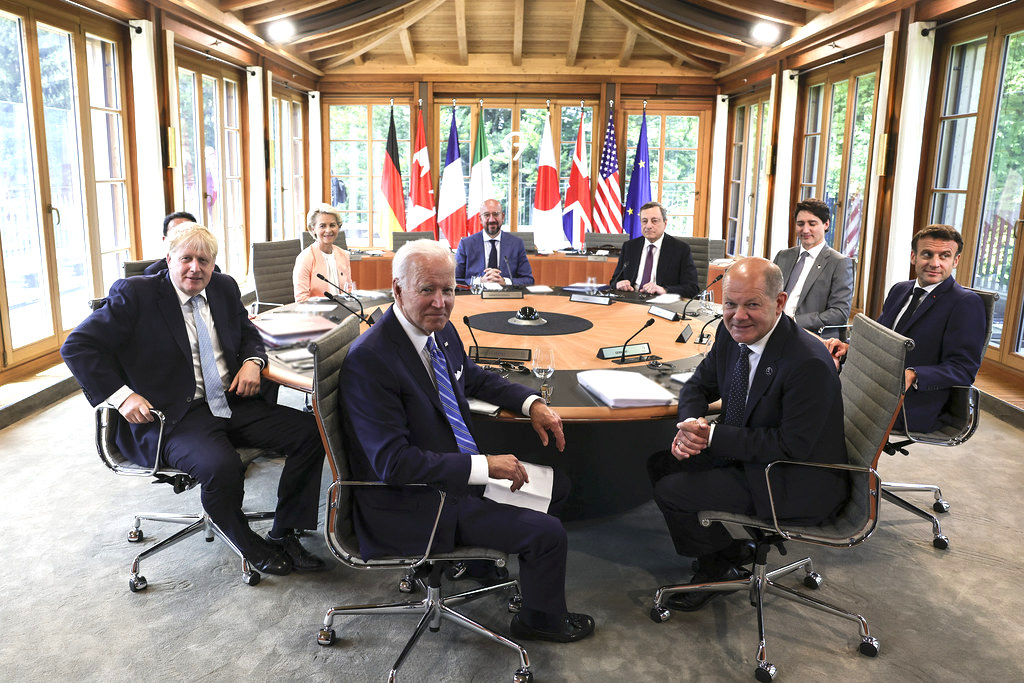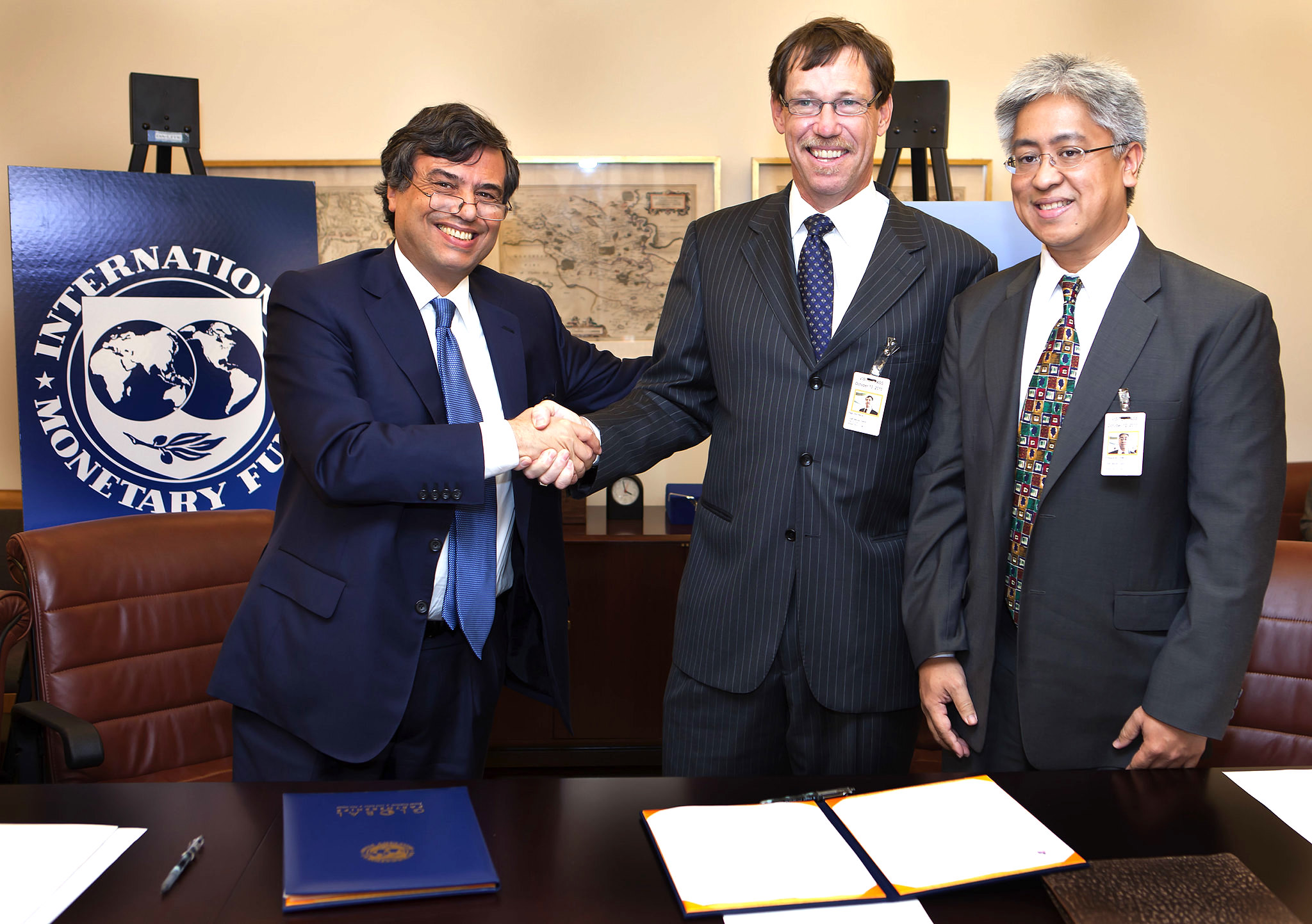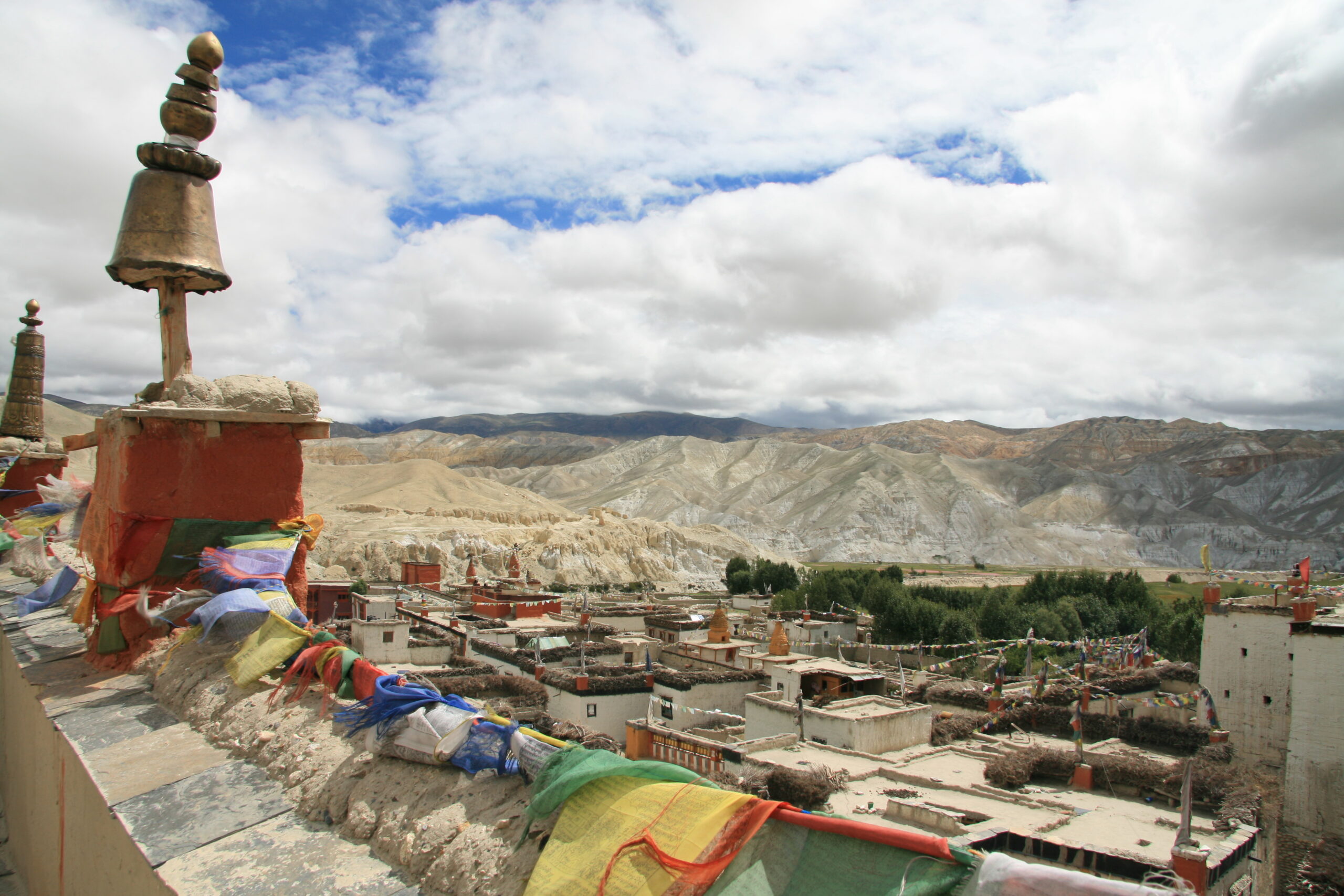Vijay Prashad responds to Biden’s announcement of another U.S. initiative to counter Beijing’s rapidly growing infrastructure development and investment project.

U.S. President Joe Biden, second from left in front, on June 26 at G7 summit in Bavaria, Germany. (Andrew Parsons, No 10 Downing Street)
By Vijay Prashad
Peoples Dispatch
 At the G7 Summit in Germany on June 26, U.S. President Joe Biden made a pledge to raise $200 billion within the United States for global infrastructure spending.
At the G7 Summit in Germany on June 26, U.S. President Joe Biden made a pledge to raise $200 billion within the United States for global infrastructure spending.
It was made clear that this new G7 project — the Partnership for Global Infrastructure and Investment (PGII) — was intended to counter the Chinese Belt and Road Initiative (BRI).
Given Biden’s failure to pass the Build Back Better bill (with its scope being almost halved from $3.5 trillion to $2.2 trillion), it is unlikely that he will get the U.S. Congress to go along with this new endeavor.
The PGII is not the first attempt by the U.S. to match the Chinese infrastructure investment globally, which initially took place bilaterally, and then after 2013 happened through the Belt and Road Initiative (BRI).
In 2004, as the U.S. war on Iraq unfolded, the United States government set up a body called the Millennium Challenge Corporation (MCC), which it called an “independent U.S. foreign assistance agency.”
Before that, most U.S. government development lending was done through the United States Agency for International Development (USAID), which was set up in 1961 as part of then-President John F. Kennedy administration’s charm campaign against the Soviet Union and against the Bandung spirit of non-alignment in the newly assertive Third World.

Alice Albright, CEO of the Millennium Challenge Corporation. (MCC, Wikimedia Commons)
Former U.S. President George W. Bush said that USAID was too bureaucratic, and so the MCC would be a project that would include both the U.S. government and the private sector. The word “corporation” in the title is deliberate. Each of the heads of the MCC, from Paul Applegarth to Alice P. Albright, has belonged to the private sector (the current head, Albright is the daughter of former U.S. Secretary of State Madeleine Albright).
The word “challenge” in MCC refers to the fact that the grants are only approved if the countries can show that they meet 20 “policy performance indicators,” ranging from civil liberties to inflation rates.
These indicators ensure that the countries seeking the grants adhere to the conventional neoliberal framework. There are also great inconsistencies among these indicators: for instance, the countries must have a high immunization rate (monitored by the World Health Organization), but at the same time they must follow the International Monetary Fund’s requirements for a tight fiscal policy. This essentially means that the public health spending of a candidate country should be kept low, resulting in the required number of public health workers not being available for the immunization programs.
The U.S. Congress provided $650 million to the MCC for its first year in 2004, as a U.S. government official told me; in 2022, the amount sought was more than $900 million.
In 2007, when Bush met with Nambaryn Enkhbayar, the former president of Mongolia, to sign an MCC grant, he said that the Millennium Challenge Account — which is administered by the MCC —
“is an important part of our foreign policy. It’s an opportunity for the United States and our taxpayers to help countries that fight corruption, that support market-based economies, and that invest in the health and education of their people.”
Clearly, the MCC is an instrument of U.S. foreign policy, but its aim seems to be not so much to tackle the Sustainable Development Goals of the United Nations (on hunger, health and education), as Bush said, but to ensure extension of the reach of U.S. influence and to inculcate the habits and structures of U.S.-led globalization (“market-based economies”).
In 2009, then-U.S. President Barack Obama developed a “pivot to Asia,” a new foreign policy orientation that had the U.S. establishment focus more attention on East and South Asia.
As part of this pivot, in 2011, former U.S. Secretary of State Hillary Clinton gave an important speech in Chennai, India, where she spoke about the creation of a New Silk Road Initiative. Clinton argued that the United States government, under Obama’s “pivot to Asia,” policy was going to develop an economic agenda that ran from the Central Asian countries to the south of India, and would thereby help integrate the Central Asian republics into a U.S. project and break the ties the region had formed with Russia and China.
The impetus for the New Silk Road was to find a way to use this development as an instrument to undermine the Taliban insurgency in Afghanistan. This U.S. project floundered due to lack of congressional funding and due to its sheer impossibility, since Afghanistan — which was the heart of this road project —could not be persuaded to submit to U.S. interests.
Two years later, in 2013, the Chinese government inaugurated the Silk Road Economic Belt project, which is now known as the Belt and Road Initiative (BRI). Rather than go from North to South, the BRI went from East to West, linking China to Central Asia and then outward to South Asia, West Asia, Europe and Africa.
The aim of this project was to bring together the Eurasian Economic Community (established in 2000) and the Shanghai Cooperation Organization (set up in 2001) to work on this new, and bigger project.
Roughly $4 trillion has been invested since 2013 in a range of projects by the BRI and its associated funding mechanisms (including the Asian Infrastructure Investment Bank and the Silk Road Fund). The investments were paid for by grants from Chinese institutions and through debt incurred by the projects at rates that are competitive with those of Western infrastructure lending programs.

Oct 12, 2010: IMF official Morello Portugal, left, concluding an agreement with U.S. Millennium Challenge Corporation’s Patrick Fine. An official from the Philippine embassy on right. (IMF/Stephen Jaffe)
The U.S. government’s “Indo-Pacific Strategy Report” (2019) notes that China uses “economic inducements and penalties” to “persuade other states to comply with its agenda.” The report provides no evidence, and indeed, scholars who have looked into these matters do not see any such evidence.
U.S. Admiral Philip S. Davidson, who previously commanded the U.S. Indo-Pacific Command, told the U.S. Congress that China is “leveraging its economic instrument of power” in Asia.
The MCC, and other instruments, including a new International Development Finance Corporation, were hastily set up to give America an edge over China in a U.S.-driven contest over the creation of infrastructure investment globally.
There is no doubt that the MCC is part of the broad Indo-Pacific strategy of the United States to undermine Chinese influence in Asia.
Only a handful of countries have thus far received MCC grants — starting with Honduras and Madagascar. These are often not very large grants, although for a country the size of Malawi or Jordan, these can have a considerable impact.
No large countries have been drawn into the MCC compact, which suggests that the United States wants to give these grants to mainly smaller countries, to strengthen their ties with the United States.
Nepal’s accession to the MCC must be seen in this broader context. Although the discovery of uranium in Nepal’s Upper Mustang region in 2014 seems to play an important role in the pressure campaign on that country.

Lo Manthang, capital of Upper Mustang, Nepal. (Boerniefischer, CC BY 3.0, Wikimedia Commons)
In May 2017, Nepal’s government signed a BRI framework agreement, which included an ambitious plan to build a railway link between China and Nepal through the Himalayas; this rail link would allow Nepal to lessen its reliance on Indian land routes for trade purposes.
Various projects began to be discussed and feasibility studies were commissioned under the BRI plan. These projects, more details for which emerged in 2019, were the extension of an electricity transmission line and the creation of a technical university in Nepal, and of course, construction of a vast network of roads and rail, which included the trans-Himalayan railway from Keyrung to Kathmandu.
During this time, the United States entered the picture with a full-scale effort to disparage the BRI funding in Nepal and to promote the use of MCC money there instead.
In September 2017, the government of Nepal signed an agreement with the United States called the Nepal Compact. This agreement — worth $500 million — is for an electricity transmission project and for a road maintenance project.
At this point, Nepal had access to both BRI and MCC funds and neither of the parties seemed to mind that fact. This provided an opportunity for Nepal to use both these resources to develop much-needed infrastructure, or as former Prime Minister Madhav Kumar Nepal told me in 2020, his country could get new loans from the Asian Development Bank.
After both deals had been signed, a political dispute broke out within Nepal, which resulted in the split of the Communist Party of Nepal and the fall of the left government. One major issue on the table was the MCC and its role in the overall Indo-Pacific strategy of the United States, which seems to be targeted against China.
Vijay Prashad is an Indian historian, editor and journalist. He is a writing fellow and chief correspondent at Globetrotter. He is an editor of LeftWord Books and the director of Tricontinental: Institute for Social Research. He is a senior non-resident fellow at Chongyang Institute for Financial Studies, Renmin University of China. He has written more than 20 books, including The Darker Nations and The Poorer Nations. His latest books are Struggle Makes Us Human: Learning from Movements for Socialism and, with Noam Chomsky, The Withdrawal: Iraq, Libya, Afghanistan, and the Fragility of US Power.
This article was produced by Globetrotter and published by Peoples Dispatch.
The views expressed are solely those of the author and may or may not reflect those of Consortium News.

“It was made clear that this new G7 project — the Partnership for Global Infrastructure and Investment (PGII) — was intended to counter the Chinese Belt and Road Initiative (BRI).”
Heads Up! “Past, present and future: The evolution of China’s incredible high-speed rail network”
“The Skunk @ the Party,” The G7. The lame & lethal executioners, y e a r s LATE! For example, while The G7 & their Party of War was smack dab in da middle of wars, “The Chinese Belt and Road Initiative (BRI) BUILT BACK BETTER “the world’s most populous nation has — by some distance — the world’s largest network of high-speed railways.” No fewer than 37,900 kilometers (about 23,500 miles) of lines crisscross the country, linking all of its major mega-city clusters, and ALL have been COMPLETED SINCE 2008.
HALF of THAT total has been completed in the last five years alone, with a further 3,700 kilometers due to open in the coming months of 2021. The network is expected to double in length again, to 70,000 kilometers, by 2035.
With maximum speeds of 350 kph (217 mph) on many lines, intercity travel has been transformed and the DOMINANCE of AIRLINES has been BROKEN on the busiest routes.
BY 2020, 75% of Chinese cities with a population of 500,000 or more had a high-speed rail link.
“Spain, which has Europe’s most extensive high-speed network and occupies second place in the global league table, is a minnow in comparison with just over 2,000 miles of dedicated lines built for operation at over 250 kph. In contrast, the UK currently has just 107 kilometers while” the Divided $tates of Corporate America, “has ONLY ONE (1) RAIL ROUTE that (just about) qualifies for high-speed status — Amtrak’s North East Corridor, where Acela trains currently top out at 240 kph on expensively rebuilt sections of existing line shared with commuter and freight trains.”
China’s ambition is to make high-speed rail the mode of choice for domestic long-distance travel, but these new railways have a much greater significance, i.e., they are a symbol of the country’s economic power, rapid modernization, growing technological prowess and increasing prosperity.
For China’s ruling Communist Party and its leader Xi Jinping, high-speed rail is also a powerful tool for social cohesion, political influence and the integration of disparate regions with distinct cultures into the mainstream.” (Updated February 9, 2022)
Et Tu, BIDEN?
The US has since WWII given less than $1 per year per capita to the world’s poorest, when it might easily have rescued the poorest half of humanity from poverty, ignorance, malnutrition, and disease. It is not capable of benevolence, only advertising. Its people have no moral foundation, firmly believe in scams, and equate personal money with virtue.
If the US feared that it had to compete with China in foreign investment rather than weapons, that could be productive.
But any payments from the US are sure to be intended as internal payoffs, bribes, and graft, so will have little benefit.
The coming war between the West and China is part of the historic hegemonic struggle for power, continuous throughout history. Two world wars in the last century, moving quickly towards a third in this century: to a conflagration that serves no one’s interests (what wars are fought for). Yet here we are.
For more on this search: A free ebook: The Pattern Of History and Fate of Humanity
“Only a handful of countries have thus far received MCC grants — starting with Honduras and Madagascar.”
I don’t know about Madagascar, but if Honduras got grants (before the recent election)
MCC’s 20 ‘policy performance indicators’ don’t rule out corrupt narco-states.
China offers real economic benefit, and the US offers threats, corruption and military bases.
The dual-deal phenom in Nepal must be the exception. But not so unlike what Yanukovich almost signed in 2014, until he read the odious IMF fine print on eternal indebtedness to the West? Brian Berletic (The New Atlas’) has detailed number of ways in which NED grants from the US go directly to terrorist groups opposing all Chinese BRI-type projects in smaller SE Asian countries. E.g., hxxps://thegrayzone.com/2021/10/17/uyghur-tribunal-us-government-china/
I’ve long been interested in NED ops at the western end, esp. Pakistan, which seemed to be the favored CIA outlet for anti-RUS propaganda in Afghanistan war, when bin Laden was our bosom buddy. Just recently, this Bolochistan separatist group has been nabbed for the bombing of 3 Chinese teachers at the Confucius Institute: hxxps://www.aljazeera.com/news/2022/7/6/pakistan-police-arrest-suspect-in-deadly-bombing-of-chinese-nationals
Same malevolent funders at both ends of BRI?
Whenever I read about China’s Belt and Road Initiative, I also read about how the US has to “counter it” somehow. This is always reported uncritically. Since the Belt and Road program sounds like a positive thing, why does the US have to counter it? Maybe they are just admitting they oppose positive things.
Yes, infrastructure projects are good but we want every cargo ship that touches the Pacific / Indian Ocean, to go through San Diego so that we have a chance to seize it. We call this a rules based world order. Allowing any infrastructure that bypasses choke points controlled by the U.S. and its proxies undermines our global hegemony.
Why else are we fuming over Russia opening up an arctic passage between Europe and Asia?
The U.S. is the only country that has seized cargo that are in transit between two other countries.
What irritates me even more is how we declare that our massive navy is for ‘freedom of navigation’ as we block the trade of civilian goods between other countries.
When are these undeveloped countries in the furthest reaches of central Eurasia that Washington wants to pry away from China’s natural sphere of influence told that their grants from the US will be funded with funny money (basically copy machine dollar bills) backed by nothing but best wishes rather than the Renminbi’s Yuan, which is formally backed by gold? Before or after they sign binding contracts to privatize their natural resources and infrastructure under the sole ownership of American corporations? And that there will be no write off or write down of the repayment of any loans should the projects fail to produce profits, as is reported to be the case between China and its third world clients?
Who can possibly still be fooled by a decaying empire’s continuing charade that it will transport its traveling circus to any point on the globe and spare no expense to buy the land and set up shop, building roads, power grids, telecommunications, clean water and sanitation, plus the necessary mines, factories, distribution depots and the ever-important military bases, while sucking every valuable resource from the landscape mainly because it wants to bring freedom, democracy, enlightenment and self-actualisation to the locals? The USA has been killing the world with “kindness” going on a couple of centuries, a role it assumes it exclusively inherited following the collapse of the British empire. Its message to China is the same as to Russia: don’t even try to develop any sphere of influence with your own “near abroad,” as America claims the entire planet its own exclusive turf. Would be a real laugh if not such a tragedy, both unfolding and soon to come.
$200 billion for… Infrastructure development within the US… Just imagine.
“Sixteen years ago, I wrote about the early challenges surrounding the development of the Transbay Transit Center, slated to become the northern terminus of a long-sought high-speed rail line connecting San Francisco to Los Angeles.
The bullet train promised to ease commutes, cut greenhouse-gas emissions, and tie together the state’s far-flung economic hubs. California established a state agency to begin planning the more than 500-mile (800-kilometer) railway back in 1996. Voters approved bonds for it in 2008, and construction has moved ahead on various legs of the development.
But along the way, it fell a decade behind schedule while the budget swelled by tens of billions of dollars. Last February, the Trump administration yanked a key piece of federal funding, halting new work from moving forward. The fate of the roughly $80 billion project, after more than two decades of planning, is now in doubt…
Major portions of the nation’s highways, bridges, water pipes, ports, railways, and electric transmission lines were constructed more than half a century ago, and in many cases they are falling apart. The American Society of Civil Engineers has estimated a $1.4 trillion gap between the funding available and the amount needed to maintain, rebuild, or develop US infrastructure between 2016 and 2025. That figure swells to $5 trillion through 2040.”
hxxps://www.technologyreview.com/2020/01/15/130892/climate-change-green-infrastructure-us-public-works-building-boom/
Sure bodes well for the US countering China’s BRI!